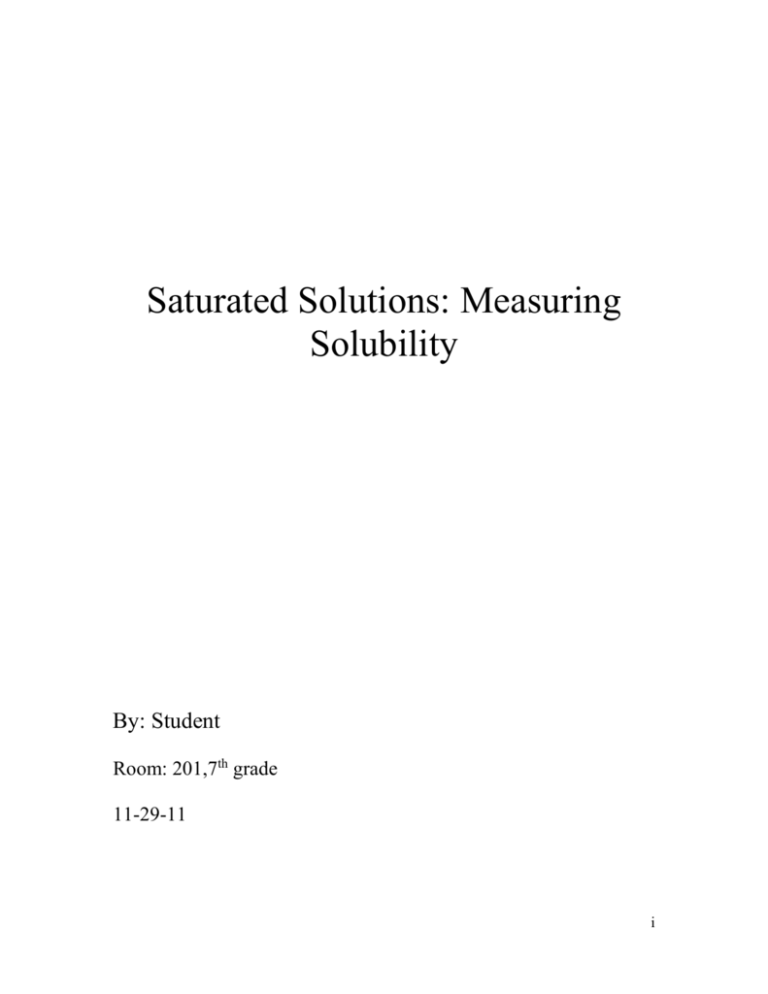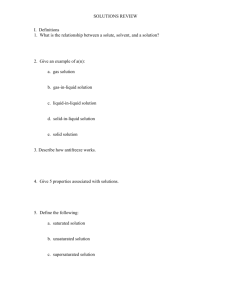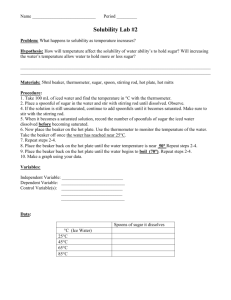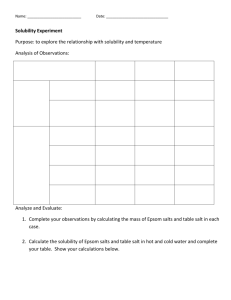Type your question here
advertisement

Saturated Solutions: Measuring Solubility By: Student Room: 201,7th grade 11-29-11 i Student Saturated solutions: Measuring Solubility Table of Contents Table of Contents ……………………………………………….i Abstract …………………………………………………………1 Safety Sheet …………………………………………………….2 Acknowledgements …………………………………………… 3 Purpose ……………………………………………………….…. 4 Hypothesis ……………………………………………………….. 5 Materials ………………………………………………………. 6 Methods of Procedure ……………………………………… 7 Results ………………………………………………………. 8 Conclusions ………………………………………………… 10 i Student Saturated solutions: Measuring Solubility Acknowledgements I would like to acknowledge my two older brothers, Ivan and Angel. They both helped me in a way with this project. Ivan took me to the stores to get the things I needed for the project. Now Angel helped me make the graph for the results, since my computer couldn’t make a graph. i Student Saturated solutions: Measuring Solubility Purpose The purpose of this experiment is to measure the solubility of household chemicals. I became interested in this experiment when in this experiment when in class we measured solvents. The information gained from this experiment would help me understand regular, everyday solutes. i Student Saturated solutions: Measuring Solubility Hypothesis I’m sure that sugar has the most solubility of the household items, the solvent or the distilled water could have effects on the solute. Since we use sugar in our coffee, tea, or any other liquid we drink. We never really realize about the solute we put in our drinks, like we never see or even feel the solute. Now the Epsom salt is probably a lot less since its large in size out of the items. This would have the solubility less. So for the table salt it has a slight size enlargement. i Student Saturated solutions: Measuring Solubility Materials Distilled Water Metric liquid cup (graduated cylinder) Three clean jars Non iodized table salt Epsom Salt Sugar Plastic spoons Pencil Journal Three shallow plates or saucers Oven (to put the saucer into) Electric kitchen balance (that measures grams) i Student Saturated solutions: Measuring Solubility Methods of Procedure 1. Get all the materials you need. 2. Now pour 100ml of distilled. 3. Use the kitchen balance to weigh the amount below to test. A. 50g Non-iodized table salt B. 50g Epsom salt C. 250g Sugar 4. Pour some of the solute into the distilled water. 5. Keep placing more and more of the solute until it won’t dissolve anymore. 6. Now weigh the rest of the solute and see how much you lost, and record it. 7. Label the underside of each saucer that the solution will go to. 8. Before anything weigh the saucer and record it. 9. Pour 10- 15ml of the solution in the saucer. 10. Weigh the plate + solution and record it in your journal. 11. Do steps 8-10 for each saturated solution. 12. Put plate in oven on low heat. 13. After all the water has evaporated weigh it and record it plate + crystal. (Hint: Do the experiment multiple times so you get right amount) i Student Saturated solutions: Measuring Solubility Results Trial 1 Solute Solute left Sugar 145.15g Table Salt 18.144g Epsom Salt 9.072g Average 57.455g Plate 752.963g 412.769g 263.084g 476.272g Plate + crystal 766.57g 417.30g 264.08g 482.65g Plate + solution 771.107g 426.377g 281.227g 492.903g Trial 2 Solute Solute left Sugar 158.76g Table Salt 18.144g Epsom Salt 9.0718g Average 61.991g Plate 752.963g 412.769g 263.084g 476.272g Plate + crystal 766.57g 417.30g 263.08g 482.31g Plate + solution 780.18g 426.38g 276.69g 494.41g Trial 3 Solute Solute left Sugar 149.69g Table Salt 18.144g Epsom Salt 9.062g Average 61.988g Plate 752.963g 412.769g 263.084g 476.272g plate + crystal 762.04g 417.30g 263.08g 480.806g Plate + solution 771.11g 426.368g 271.78g 489.75g i i Student Saturated solutions: Measuring Solubility Conclusion The data in this experiment has proven that my hypothesis was wrong. Actually Epsom salt had the most solubility of the three, and sugar my guess was with the least. Like it shows in the table and graph that the smaller amount you have the more solubility it has. Now you might be saying that sugar has the most solubility but it doesn’t since we put 250g of sugar we have to scale down. So that it can be compared with the others. The plate and solution was to compare the after results or, plate and crystal. Possible errors that this experiment could have are actually vital. Like in the experiment, when I put the solution and the plate in the oven in one of my trials it burned when I took it out. Adding time to how long the solution should stay in the oven would give even more accurate results. So you know that it didn’t lose more weigh than the others. Or like the fact that it doesn’t tell how it looks like when you have found the solubility. i I have definitely learned a lot from this project. Like sugar not having a great amount of solubility. Or like the size of the solute doesn’t matter it counts on the solubility. But if the project were to go on I would use different solvents like tab water. So if it also depended on the solvent we used. The highest solubility was Epsom salt and the least solubility was the sugar which probably absorbs the water so it comes to be smaller. i Student Saturated solutions: Measuring Solubility Safety Be careful when you’re touching the oven it can get hot. Get help by an adult when you’re turning on the oven and turning it off. Also note that the water like Epsom can be dangerous if eaten. i i






